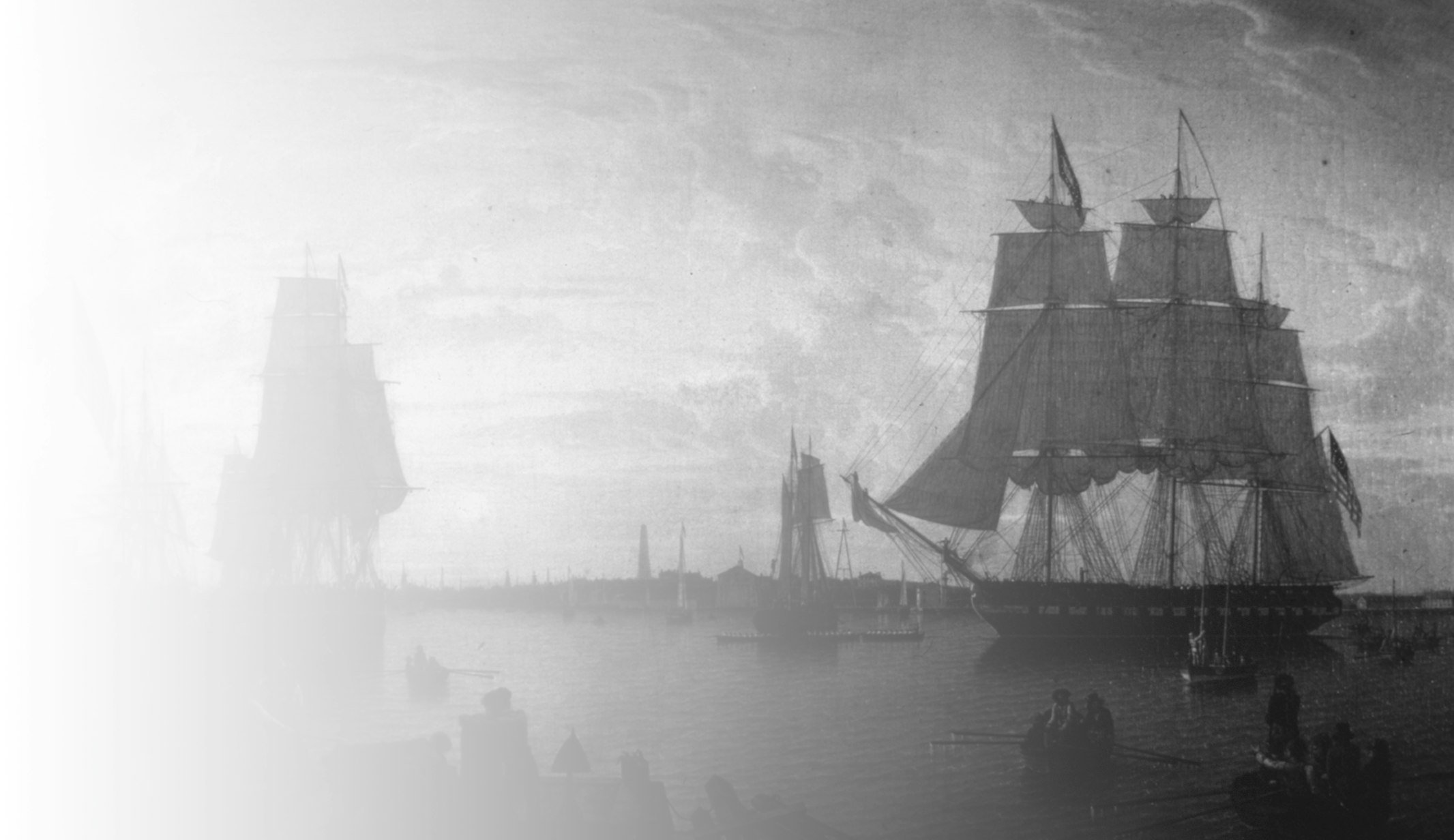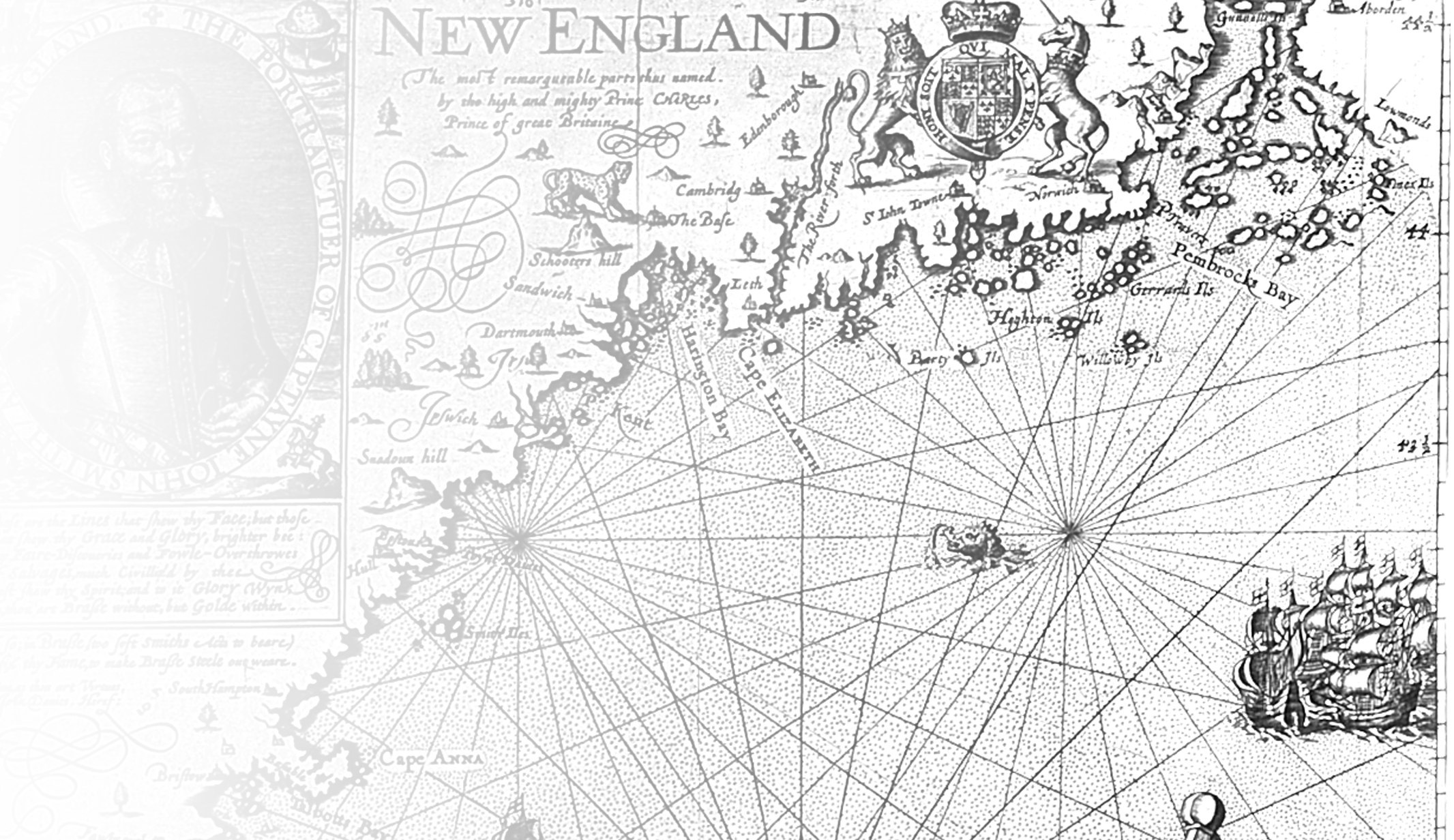
Slavery in New England and at Harvard
Harvard University’s early history is inseparable from that of colonial New England and, thus, from the system of slavery. Harvard was important to the region’s politics, society, and economy, and as slavery formed the basis of New England’s economic life, so it shaped Harvard.Go to footnote 94 detail
Leading historians agree that the colonial economy thrived based on “an economic alliance with the sugar islands of the West Indies.”Go to footnote 95 detail This trade involved the provision of food, fuel, and lumber produced in New England to plantations of the Caribbean, where those goods were exchanged for tobacco, coffee, and sugar produced by enslaved Africans—or for enslaved people themselves.Go to footnote 96 detail “This effectively made Boston a slave society,” according to one historian, “but one where most of the enslaved toiled elsewhere, sustaining the illusion of Boston in New England as an inclusive republic devoted to the common good.”Go to footnote 97 detail Yet slavery was not absent from New England.
By 1700, New Englanders had made at least 19 voyages to Africa and then to the West Indies, the chief route of the slave trade, as well as many more voyages between Massachusetts Bay and the Caribbean.Go to footnote 98 detail The Massachusetts Bay Colony’s Body of Liberties, written in 1641, made slavery and the slave trade lawful. The first legal code governing slavery in British North America, it prohibited “bond-slavery,” “unless it be of lawfull captives, taken in just warrs, and such strangers as willingly sell themselves, or are solde to us,” leading one historian to note, “the word ‘unless’ has seldom carried more baggage.”Go to footnote 99 detail Even as it paid homage to the Magna Carta, the Body of Liberties permitted the buying, selling, and trading of Indigenous people and Africans. Slavery would not officially end in Massachusetts until 1783.
Indigenous Slavery and African Slavery
Slavery in New England began when early colonists enslaved and sold Indigenous people while dispossessing these Native peoples of the land on which they had lived for generations.Go to footnote 100 detail
In 1636, the year Harvard was founded, merchants at Marblehead built and rigged a ship, 120 tons and very fast, called Desire. That summer, the Desire set sail carrying 17 Pequot War prisoners who were to be sold as slaves in Bermuda on the instructions of John Winthrop.Go to footnote 101 detail A towering figure in early colonial history who served several terms as Governor and Lieutenant Governor of the Massachusetts Bay Colony, Winthrop was a member of the original “Comittee as to ye colledg at New Toune”—that is, Harvard.Go to footnote 102 detail Winthrop himself enslaved the wife of a Pequot sachem and her two children in what he seems to have regarded as an act of Christian benevolence, reciprocity for her protection of two captured English girls during the conflict.Go to footnote 103 detail
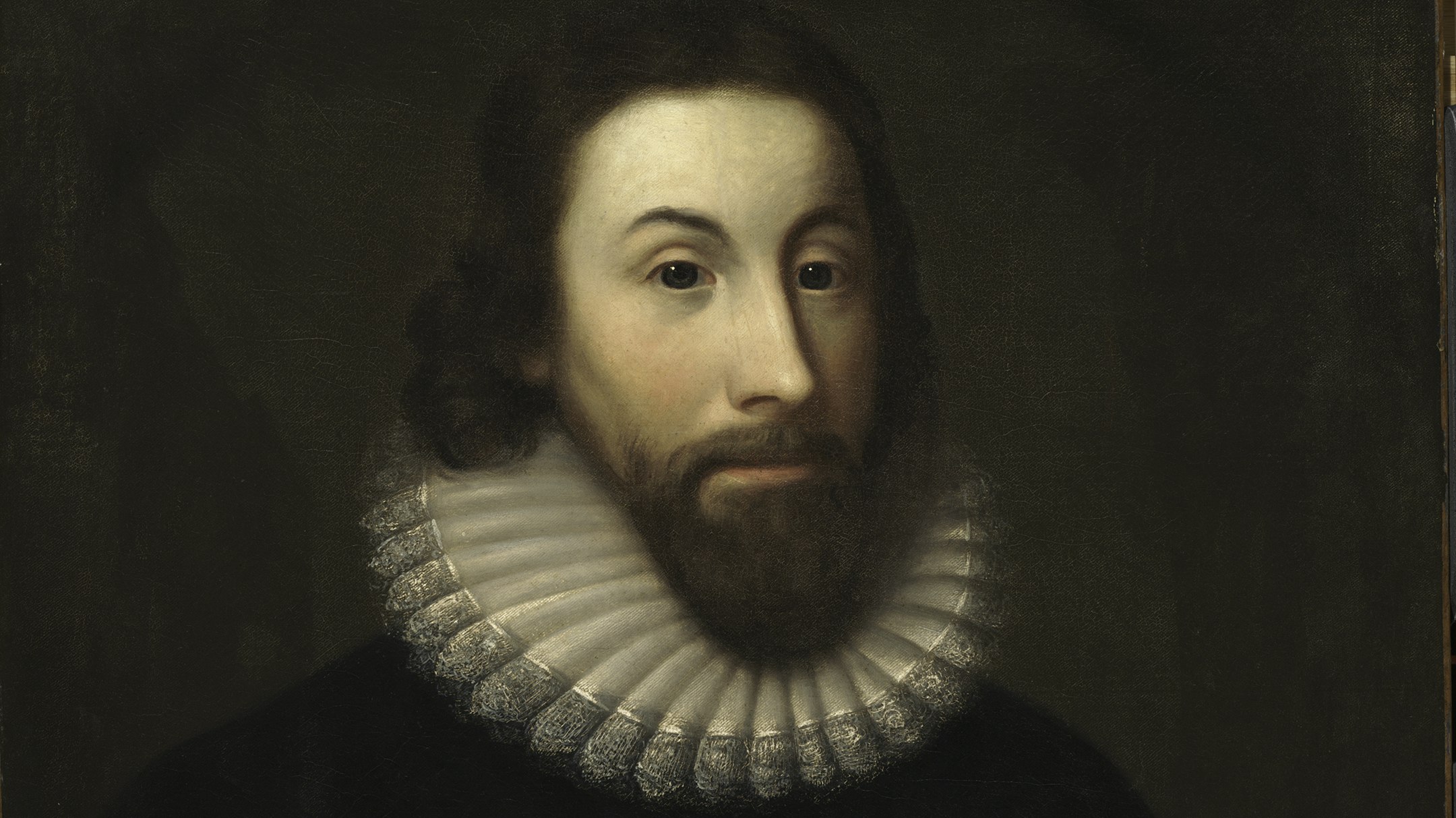
Two years later, on February 26, 1638, the Desire returned to Boston Harbor carrying cotton, tobacco, salt, and an unspecified number of enslaved Africans who had been purchased on Providence Island. The Desire was among the first American slave ships.Go to footnote 104 detail It is possible that the man known to us only as “The Moor”—who was enslaved by Harvard’s first schoolmaster, Nathaniel Eaton, and in that capacity served Harvard’s earliest students—arrived in New England aboard the Desire.Go to footnote 105 detail
Not long after, in the early 1640s, a Bermuda minister named Patrick Copeland, grateful for Winthrop’s “remembrance of us in sending 12 New England Indians to us,” began recruiting the children of wealthy Caribbean plantation owners to attend Harvard.Go to footnote 106 detail As one historian has noted, “education, like the flag, follows trade”—and many sons of West Indian planters indeed followed trade to the Massachusetts Bay Colony and Harvard.Go to footnote 107 detail
Harvard also benefited from land grants by the General Court (the colonial legislature) in 1653:
For the incouragement of Harvard Colledge and the society thereof, and for the more comfortable maintenance and provicon for the psident, ffellowes, and students thereof in time to come, this Court doth graunt unto the said society and corporation, for the ends aforesaid, two thousand acres of land wthin this jurisdiccion, not formerly graunted to any other, to be taken up in two or three places, where it may be found convenient; and to this end it is desired that the said corporation of the college doe appoint some persons in theire behalfe to finde out the places where such land may be freely taken, and to make retourne as soone as they may, that the Court may more pticcularly and expressly confirme the same.Go to footnote 108 detail
The Harvard treasurer Thomas Danforth personally selected four tracts in Rhode Island and Connecticut, territory from which the Pequot had been driven.Go to footnote 109 detail
One aspect of the original mission of Harvard College was to educate (and convert) Native students alongside white classmates.Go to footnote 110 detail In the 1640s, the fledgling Colony was in the throes of an economic crisis, and the College was on the edge of collapse: Christianizing Indigenous people opened up vital new avenues of financial support. Devoted Puritans in England lined up to support the mission, and Parliament opened its coffers to aid the colonization effort by “civilizing” Natives.Go to footnote 111 detail The Charter of 1650, which has governed Harvard with few interruptions for more than 350 years, committed the institution to “the education of the English and Indian youth.”Go to footnote 112 detail The Indian College building—Harvard’s first made of brick—was constructed in 1655. Ultimately, however, Harvard enrolled only five Native students in this era, and only Caleb Cheeshahteaumuck (AB 1665) received a degree during his lifetime.Go to footnote 113 detail (Joel Iacoombs also completed the requirements of the AB degree but died in 1665 before he formally graduated. Harvard University posthumously presented Iacoombs’s degree to the Wampanoag community in 2011.Go to footnote 114 detail) By 1670, the Indian College building had been given over to the College’s printing press, and in 1698, it was dismantled, and its bricks were used to construct a new building for the use of white scholars.Go to footnote 115 detail
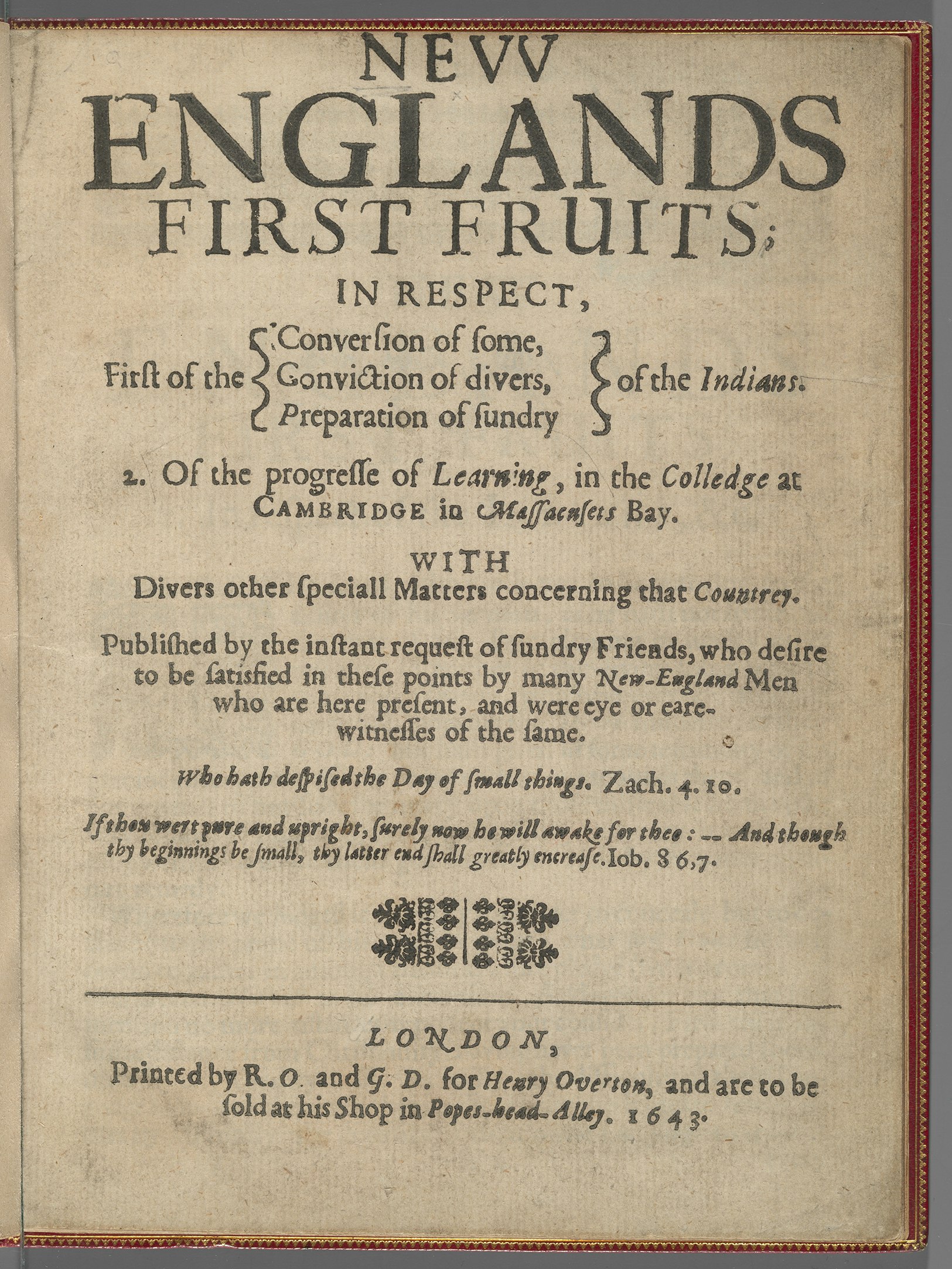
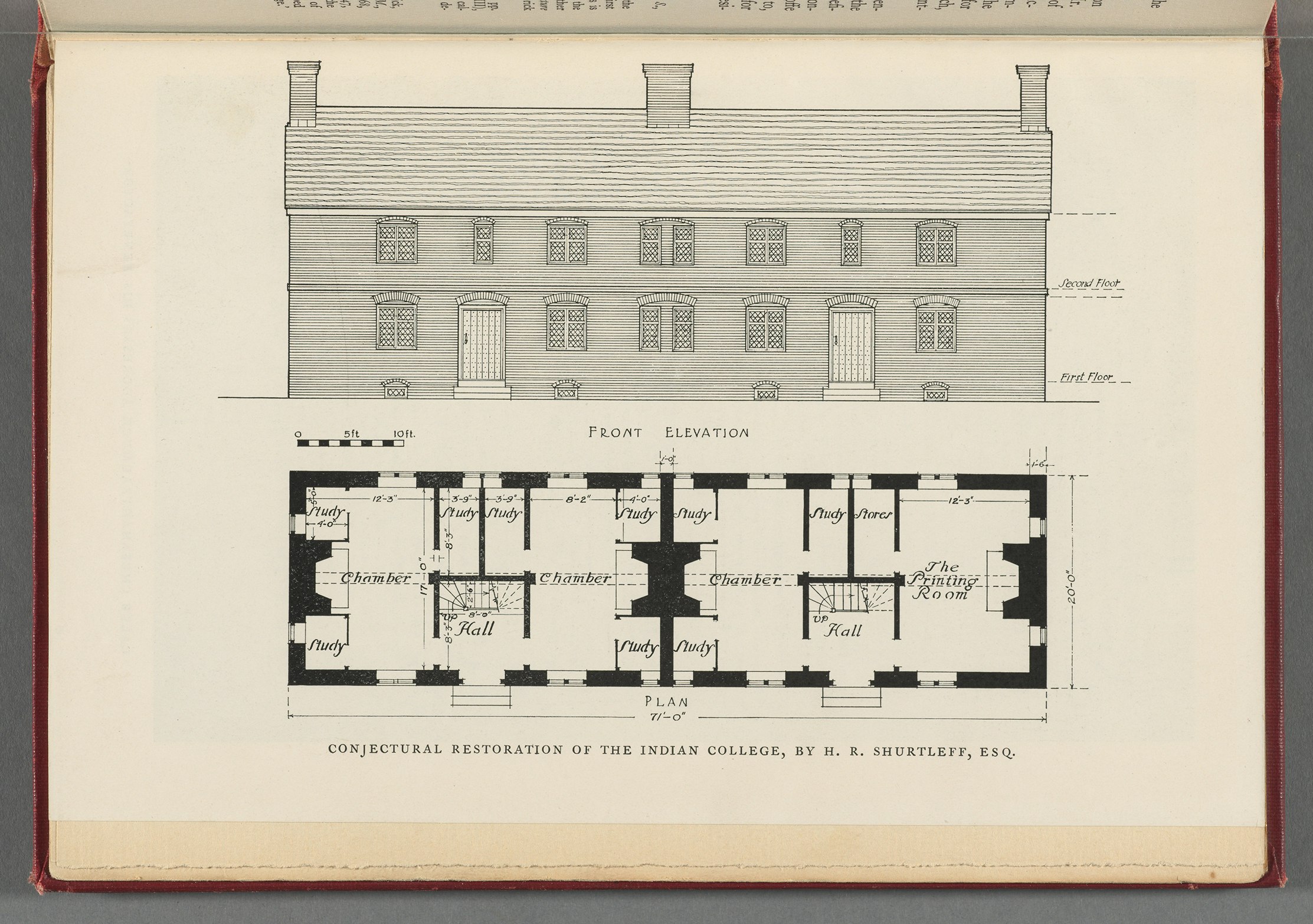
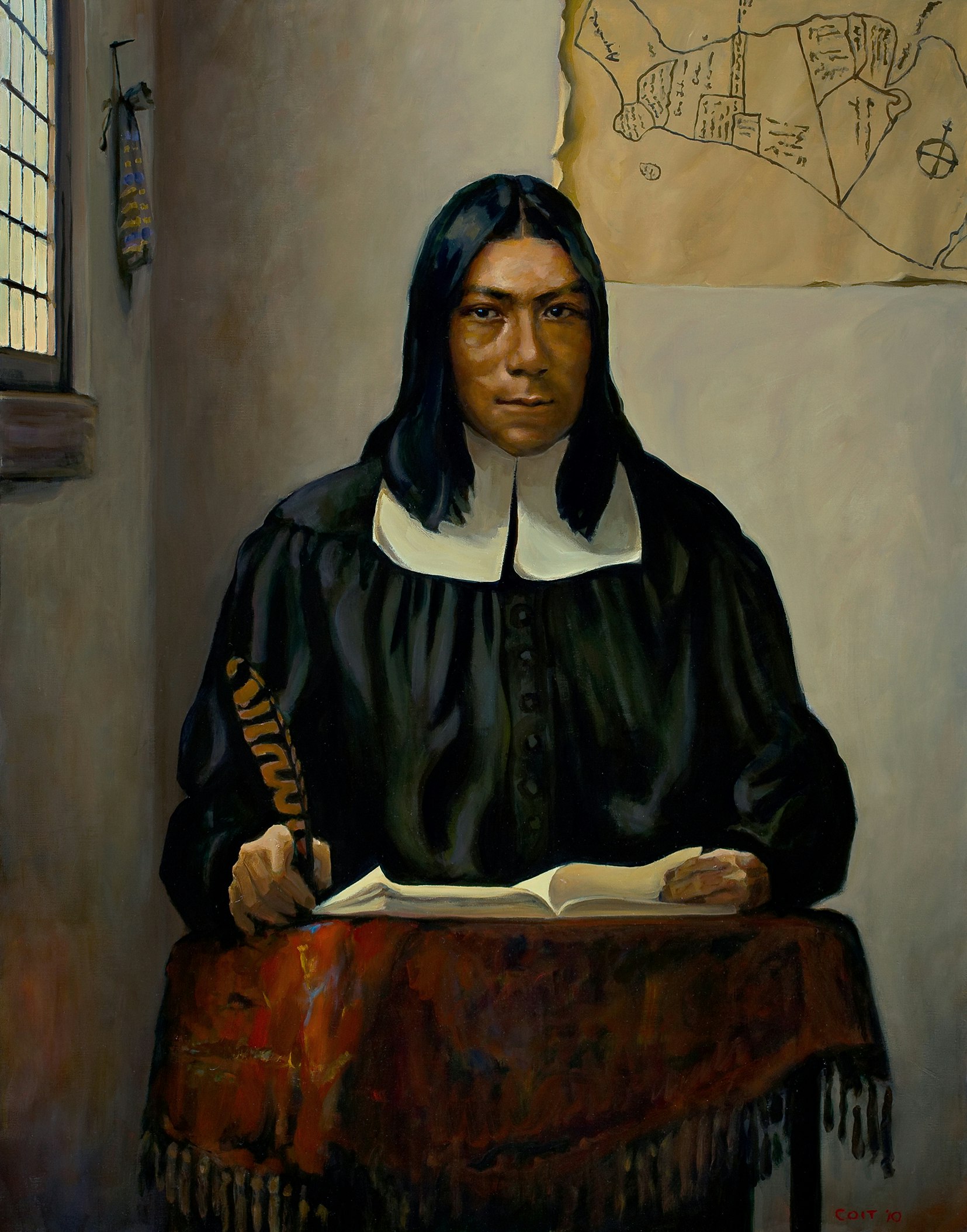



As the colony grew, slavery—now primarily, but not exclusively, African slavery—remained central. In the colonial era, the system that W. E. B. Du Bois would eloquently describe more than two centuries later was just beginning to take shape:
The giant forces of water and of steam were harnessed to do the world’s work, and the black workers of America bent at the bottom of a growing pyramid of commerce and industry; and they not only could not be spared, if this new economic organization was to expand, but rather they became the cause of new political demands and alignments, of new dreams of power and visions of empire. …
Black labor became the foundation stone not only of the Southern social structure, but of Northern manufacture and commerce, of the English factory system, of European commerce, of buying and selling on a world-wide scale; new cities were built on the results of black labor.Go to footnote 116 detail
The number of enslaved women, men, and children in Massachusetts, itself a small colony of some 33,000 inhabitants according to a 1675 census,Go to footnote 117 detail remained relatively low until the end of the 17th century, and enslaved people formed part of a larger world of unfree labor that also included indentured white servants.Go to footnote 118 detail In 1676, colonial administrator Edward Randolph wrote that there were “not above 200 slaves in the colony, and those are brought from Guinea and Madagascar.”Go to footnote 119 detail Four years later, Governor Simon Bradstreet told the Lords of the Committee for Trade and Foreign Plantations that “there are a very few blacks borne here, I think not above [five] or six at the most in a year.”Go to footnote 120 detail Unlike white indentured servants, who eventually left their unfree status behind, these enslaved Africans faced lifetimes of uncompensated labor, both for themselves and for their descendants.
The enslaved population of Massachusetts rose quickly after the British Parliament’s revocation of the Royal African Company’s monopoly on English trade with Africa in 1696.Go to footnote 121 detail It was also at this time that some New Englanders “began to rebel against the growth of actual slavery on New England soil.”Go to footnote 122 detail
Antislavery sentiment was not, however, at the root of resistance in this period.Go to footnote 123 detail Rather, limited opposition to slavery grew largely out of a concern about the growing presence of Black people and the effect that would have on society, fears that had gained salience in the wake of Bacon’s Rebellion in 1677. These concerns culminated in the passage in 1705 of an act “for the Better Preventing of a Spurious and Mixt Issue,” which put a prohibitive £4 tax on all slaves imported.Go to footnote 124 detail The colonial legislature also adopted other measures designed to maintain the racial balance, such as the 1709 “Act to Encourage the Importation of White Servants,” which promised payment of forty shillings per white male servant imported into the colony and extended the 1705 import tax to include enslaved Native Americans.Go to footnote 125 detail Despite such efforts, the number of enslaved people in the Massachusetts Bay Colony rose to 550 by 1708, and in 1720, Governor Samuel Shute wrote that “With respect to slaves either Negros or Indians (but most Negroes) they may be computed at about Two Thousand” alongside an English population of 94,000.Go to footnote 126 detail By the middle of the 18th century, enslaved Black people constituted the main source of bound labor in Massachusetts, outnumbering indentured servants, apprentices, and Indigenous workers.Go to footnote 127 detail
Slavery at Harvard

On Harvard’s campus, the story was much the same. Over nearly 150 years, from the University’s founding in 1636 until the Massachusetts Supreme Judicial Court found slavery unlawful, Harvard presidents and other leaders, as well as its faculty and staff, enslaved more than 70 individuals, some of whom labored on campus.Go to footnote 128 detail Enslaved men and women served Harvard presidents and professors and fed and cared for Harvard students.
The enslaved man known as “The Moor,” who could have arrived aboard the Desire, was the first of many enslaved people who would serve Harvard students in the colonial era. Titus, Venus, Juba, and Bilhah, all enslaved people, served Harvard Presidents Benjamin Wadsworth (1725–1737) and Edward Holyoke (1737–1769).Go to footnote 129 detail Yet more people were enslaved by Harvard’s stewards and, in this capacity, likely served Harvard’s students and maintained its campus.Go to footnote 130 detail

The steward was a prominent role in the early years of the College, one that commanded respect and status.Go to footnote 131 detail Stewards were responsible for feeding the scholars on campus, along with collecting student fees, overseeing staff engaged in student services, and paying many of the College’s bills. They also provided lavish feasts for the annual Commencement celebrations. From Harvard’s founding, in 1636, through the beginning of the American Revolution, only 10 men—5 from the same family—held the position.Go to footnote 132 detail Of these 10, at least 3 owned enslaved people whose labor maintained the Harvard campus and sustained Harvard students.Go to footnote 133 detail
Among the Harvard stewards who owned enslaved people, Andrew Bordman (II), steward from 1703 to 1747, stands out for having enslaved at least eight individuals. The documentation of his slaveholding is also characteristic of the period’s sparse records, but the picture becomes clear when the evidence is viewed as a whole: First, a deed of sale shows that Bordman paid £40 to buy a man named Cuffe and that his brother-in-law, future Harvard President Benjamin Wadsworth, witnessed the purchase.Go to footnote 134 detail Separately, in the steward’s notebook, Bordman recorded the names of four children born to a woman named Rose: Flora, Jeffrey, Cesar, and Jane, an enslaved woman who died at the age of 22.Go to footnote 736 detail
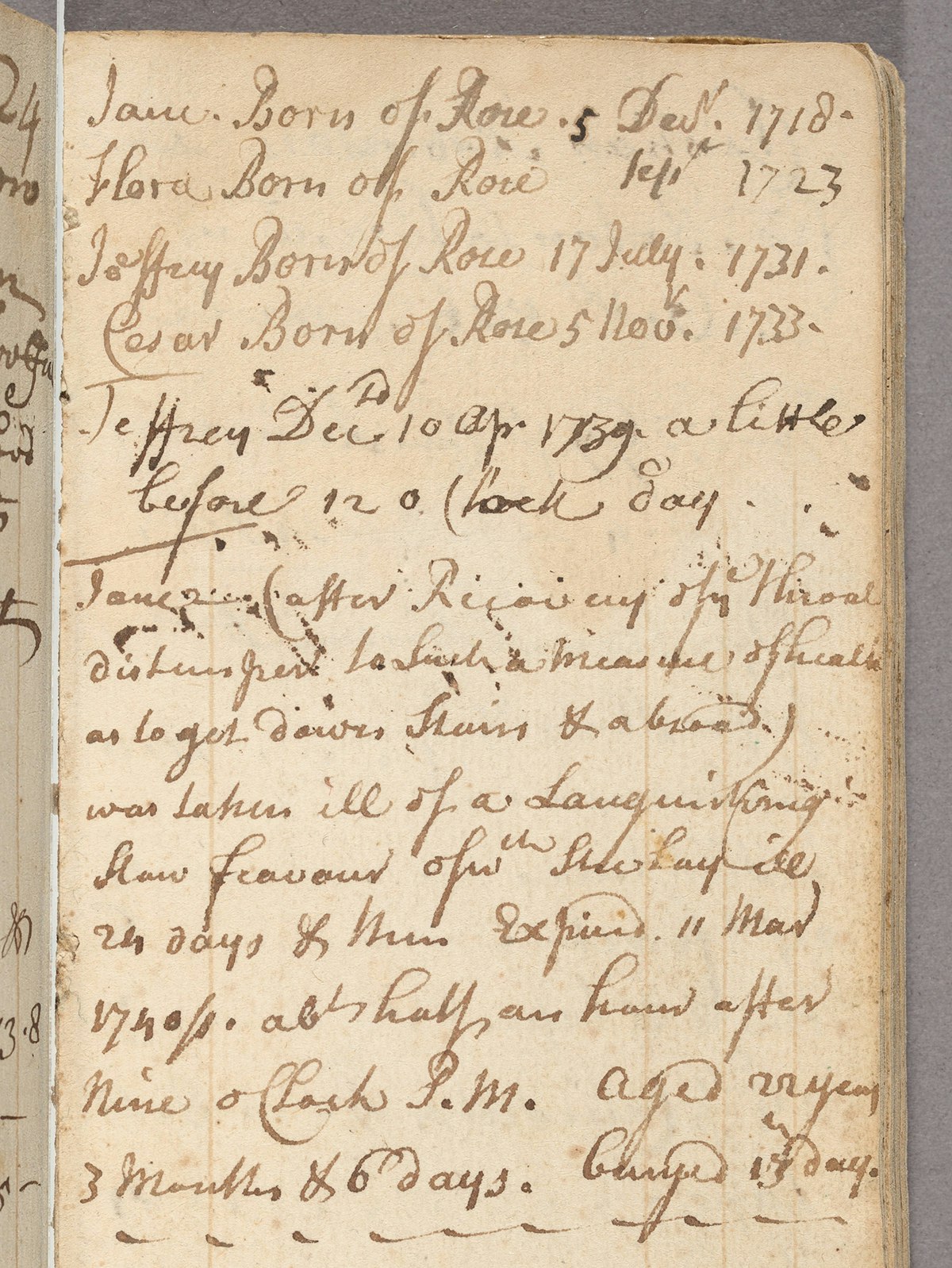
Jane’s tombstone still stands in the Old Burying Ground near Harvard Yard, inscribed “Jane a Negro Servant of Andrew Bordman,”Go to footnote 135 detail and it is adjacent to a similar memorial of Cicely, a Black woman enslaved by the Harvard tutor, fellow, and treasurer William Brattle.Go to footnote 136 detail We know that Rose and her other children were also enslaved because according to Massachusetts law at this time, children inherited the status of their mothers: if Jane was enslaved, then so too were her mother and siblings.Go to footnote 137 detail Two additional people enslaved by Andrew Bordman and his widow, Elizabeth Bordman, appear in extant records: Lucy, “Indian servant of Mr. Bordman,” was baptized in 1740.Go to footnote 138 detail Peter, “negro man servant of Mrs. Elizabeth Bordman,” married a woman enslaved in Charlestown in 1758.Go to footnote 139 detail We cannot know whether the Bordman family owned all eight of these people at the same time. But if Andrew Bordman owned even Rose and her four children all at once, this would have made him one of the largest slaveholders in the colony; in the only surviving tax assessment for the town of Cambridge during this period, from 1749, the largest number of enslaved people recorded in a single household was four.Go to footnote 140 detail Such was Bordman’s reliance on enslaved labor to feed Harvard’s students and fulfill his duties as steward.
Other Harvard leaders and faculty members also owned enslaved people in this period. Take, for example, Professor John Winthrop. A direct descendant of the colonial governor of the same name, Winthrop earned his AM from Harvard in 1732 and served as Hollis Professor of Mathematics and Natural Philosophy from 1738 until his death in 1779. He was also a fellow from 1765 to 1779 and served as acting president in 1769 and again from 1773 to 1774.Go to footnote 141 detail Harvard’s Winthrop House is named for Professor Winthrop as well as for his ancestor, the colonial governor.Go to footnote 142 detail

On a single page of his 1759 Ames Almanack, Winthrop notes the death of his enslaved “negro man George.”
13 may, a few minutes before one in y morng [abt hi watr], our poor George died of a hectic, wch he was thrown into by y measles; havg never been well since he had yt distemp. He was aged 24 years & one day.Go to footnote 143 detail
Further down the same page Winthrop recorded that he procured a replacement:
had a new negro boy, wm I call Scipio. He now measures 3 feet & 11 inches, wtht shoes. By comparg his ht wth yt of our boys, I jdg him to be 8 ½ y old.Go to footnote 144 detail

It is unclear when Winthrop acquired this boy; not all of his notes are dated. In a subsequent note, this one dated February 6, 1761, Winthrop provides additional information about his own son’s age and height, the basis for his estimate of Scipio’s eight and a half years.Go to footnote 737 detail
The fact of Winthrop’s slaveholding is not new; it is noted in Sibley’s Harvard Graduates, a compendium of biographical sketches of colonial-era Harvard alumni. But the story, as told in Sibley’s, is sympathetic. The passage on George’s death reads: “When [Winthrop’s] own slave boy, George, died of the measles, he was mourned as one of the family, not as an unfortunate investment.” As for Scipio, Sibley’s reports he “was watched over like the white children of the family.”Go to footnote 145 detail The truth, however, is that Scipio and George were undoubtedly purchased to labor for the Winthrops without compensation.
In 1773, a decade or so after Winthrop purchased Scipio and several years before the official end of slavery in the Commonwealth, human bondage captivated an audience at Harvard’s Commencement ceremony. Two candidates for the bachelor’s degree, Eliphalet Pearson and Theodore Parsons, participated in a public debate concerning the legality of slavery. Parsons, then 21 years old, took the antislavery position:
To me, I confess, it is a matter of painful astonishment… that those who are so readily disposed to urge the principles of natural equality in defence of their own Liberties should, with so little reluctance, continue to exert a power by the operation of which they are so flagrantly contradicted. For what less can be said of that exercise of power, whereby such multitudes of our fellow-men, descendants, my friend from the same common parent with you and me, and between whom and us nature has made no distinction, save what arises from the stronger influence of the sun in the climate whence they originated, are held to groan under the insupportable burden of the most abject slavery.Go to footnote 146 detail

Defending slavery, Pearson called for the abandonment of “tender sentiment” and a calm return to “the voice of reason.” Although he conceded “[t]hat Liberty to all is sweet” he went on to argue that slavery was a benefit to Africans, who had in his view been rescued by slavers: characterizing life in Africa as “an entire subjection to the tyrannizing power of lust and passion,” Pearson implored the audience, “reflect, I say, a moment upon the condition of a creature in human shape (for in such a state of degradation one can hardly call him a man), the misery, the wretchedness … and compare it with the condition of a slave in this country.” He concluded, the slaves’ “removal [from Africa] is to be esteemed a favor.”Go to footnote 147 detail
Slavery was not an abstraction to either man, nor to the other students and faculty at Harvard. Slavery had, by this time, long been a fact of everyday life in Massachusetts. Parsons’s impassioned argument against the institution was about more than overheard tales of abject brutality in the sugarcane fields of the Caribbean, to which New England was economically tied. His father, Reverend Moses Parsons, owned two men and a woman named Violet. Parsons’s son later recalled: “When it was generally believed that slavery was unlawful in Massachusetts, [the Reverend] summoned his slaves into his sitting-room, and there, in the presence of his children, declared to them that they were free. The men accepted the gift, or rather the declaration, for gift it was not.”Go to footnote 148 detail Yet Violet, who would have been about eight years older than Parsons, roughly as old as his eldest brother, stayed with the Parsons family until her death at the age of ninety, and is now buried in the Parsons family tomb in Byfield, Massachusetts. John Thornton Kirkland, president of Harvard University, officiated her funeral.Go to footnote 149 detail
Theodore Parsons became a doctor. Six years after his graduation from Harvard College, at age 28, he shipped aboard the warship Bennington as its surgeon. He disappeared at sea a few days later, and his body was never found.Go to footnote 150 detail Eliphalet Pearson became Harvard’s Hancock Professor of Hebrew and Other Oriental Languages in 1786 and served as president of the University from 1804 to 1806. He died in 1826.Go to footnote 151 detail
Footnotes
-
“Throughout New England before 1700, and in subregions thereafter, Native Americans represented the dominant form of nonwhite labor,” Newell, Brethren by Nature, 5. See also Warren, New England Bound and Jared Ross Hardesty, Black Lives, Native Lands, White Worlds: A History of Slavery in New England (Amherst and Boston: Bright Leaf, An Imprint of University of Massachusetts Press, 2019).
-
See Wilder, Ebony & Ivy, 25.
“The enslavement of the Pequots was the first large-scale, institutionalized distribution of people as property in the British North American colonies.” Franco Paz, “On the Edge of Freedom: The Re-enslavement of Elizabeth Watson,” MA thesis (University of Vermont, 2018), 32, accessed March 1, 2024, https://scholarworks.uvm.edu/graddis/905/. Paz cites Greene, Negro in Colonial New England, 16, and George Henry Moore, Notes on the History of Slavery in Massachusetts (New York, NY: D. Appleton & Co., 1866), 7–8, https://books.google.com/books?id=ohsEAAAAYAAJ. See also Newell, “’David’s warre’ The Pequot War and the Origins of Slavery,” chap. 1 in, Brethren by Nature.
As several historians have noted, due to a navigational error the Pequot prisoners of war were in fact sold in the Puritan colony of Providence Island. They did not arrive in Bermuda until 1640. See Paz, “On the Edge of Freedom,” 32 n. 5, accessed March 1, 2024, https://scholarworks.uvm.edu/graddis/905/; Newell, Brethren by Nature, 50–51; Ethel Boissevain, “Whatever Became of the New England Indians Shipped to Bermuda to be Sold as Slaves?” Man in the Northeast 21 (1981): 103–114; F. Van Wyck Mason, “Bermuda’s Pequots,” Harvard Alumni Bulletin 39 (February 26, 1937): 616–620; Karen Ordahl Kupperman, Providence Island, 1630–1641: The Other Puritan Colony (Cambridge, UK: Cambridge University Press, 1993).
-
John Langdon Sibley, Biographical sketches of graduates of Harvard University in Cambridge, Massachusetts, Volume I, 1642-1658 (Cambridge, MA: Charles William Sever, University Bookstore, 1873), 1-7, https://books.google.com/books?id=SRZSAQAAMAAJ.
-
Newell, Brethren by Nature, 40-41, 79; Manegold, Ten Hills Farm, 42; Francis J. Bremer, John Winthrop: America’s Forgotten Founding Father (New York: Oxford University Press, 2003), 273. See also John Winthrop to William Bradford, Winthrop Family Papers, Massachusetts Historical Society, accessed August 27, 2021, https://www.masshist.org/publications/winthrop/index.php/view/PWF03d358.
-
George Francis Dow, Slave Ships and Slaving (Reprint, New York, NY: Dover Publications 2002), 267; George Henry Preble, “Notes on Early Ship-Building in Massachusetts,” The New-England Historical and Genealogical Register and Antiquarian Journal 25, no. 1 (1871): 17; James Kendall Hosmer, ed., Winthrop’s Journal: History of New England, 1630-1649, vol. 1, (New York, NY: Charles Scribner’s Sons, 1908), 260, https://books.google.com/books?id=Iwo6FnGALocC.
-
On Eaton’s tenure as schoolmaster, see Morison, Three Centuries of Harvard, 7–10. See also Susan E. Maycock and Charles M. Sullivan, Building Old Cambridge: Architecture and Development (Cambridge, MA: MIT Press, 2016), 8; Margery Somers Foster, Out of Smalle Beginnings: An Economic History of Harvard College in the Puritan Period (1636 to 1712) (Boston, MA: Belknap Press of Harvard University Press, 1962), 5–6. On “the Moor,” see John Winthrop, The History of New England from 1630 to 1649, vol. 1, ed. James Savage (Boston, MA: Little, Brown, 1853), 372–375, https://books.google.com/books?id=KIarrcIX7QAC. Winthrop’s description of the Moor was reprinted in Sibley, Biographical sketches of graduates, 5.
-
Patrick Copeland to John Winthrop, December 4, 1639, Papers of the Winthrop Family, vol. 4, Massachusetts Historical Society.
-
John Irwin Cooper, “The West Indies, Bermuda and American Mainland Colleges,” Jamaican Historical Review 2, no. 1 (December 1, 1949): 2.
-
Records of the Governor and Company of the Massachusetts Bay in New England, vol. 4, pt. 1, Records, 1650–1660 (Boston, MA: William White, 1854), 136, accessed February 4, 2022, https://books.google.com/books?id=XG9OAQAAMAAJ.
-
Robin Stephen McMahon, “Contested Boundaries: The Harvard Land Grants as an Archetype for Intercolonial Competition for Land,” Connecticut History Review 56, no. 2 (Fall 2017): 203-209.
-
Charter of 1650, Harvard University Archives, https://iiif.lib.harvard.edu/manifests/view/ids:6597921$1i. For a transcription, see “Harvard Charter of 1650,” Harvard Library, Harvard University, accessed February 4, 2022, https://guides.library.harvard.edu/c.php?g=880222&p=6323072; Foster, Smalle Beginnings, 2.
-
Lisa Brooks, Our Beloved Kin: A New History of King Philip’s War (New Haven, CT: Yale University Press, 2018), 81-82, 97-99; Foster, Smalle Beginnings, 107-109, 117-118.
-
Charter of 1650, Harvard University Archives.
-
Brooks, Our Beloved Kin, 102-106. See also “Digging Veritas - The Indian College,” Peabody Museum of Archaeology & Ethnology, Harvard University, accessed January 25, 2022, https://peabody.harvard.edu/galleries/digging-veritas-indian-college.
-
“A Degree Delivered: Harvard honors Native American who completed course work in 1665,” Harvard Gazette, May 26, 2011, https://news.harvard.edu/gazette/story/2011/05/a-degree-delivered/.
-
Maycock and Sullivan, Building Old Cambridge, 755.
-
Du Bois, Black Reconstruction, 7.
-
United States Bureau of the Census, A century of population growth from the first census of the United States to the twelfth, 1790-1900 (Baltimore, MD: Genealogical Publishing Company, 1969), 5, https://www2.census.gov/library/publications/decennial/1900/century-of-growth/1790-1900-century-of-growth-part-1.pdf.
-
White indentured servants in the New England colonies faced harsher conditions than those in England, but in general could count on masters to honor the agreed upon duration of their indenture and release them at the end of their terms. For Native people, however, masters routinely ignored terms of indenture and held servants for life—sometimes forcing their children into servitude as well—effectively rendering them enslaved in practice regardless of whether the law allowed it or not. See Newell, 12-15, “‘As good if not better then the Moorish Slaves’: Law, Slavery, and the Second Native Diaspora,” chap. 7, and “To be sold ‘in any part of ye kings Dominyons’: Judicial Enslavement of New England Indians,” chap. 9 in Brethren by Nature.
-
Edward Randolph: including his letters and official papers from the New England, middle, and southern colonies in America, with other documents relating chiefly to the vacating of the royal charter of the colony of Massachusetts Bay, 1676-1703, with historical illustrations and a memoir by Robert Noxon Toppan, 5 vols. (Boston, MA: The Prince Society, 1898), 2:236, https://books.google.com/books?id=iaAUAAAAYAAJ, with historical illustrations and a memoir by Robert Noxon Toppan, 5 vols. (Boston, MA: The Prince Society, 1898), 2:236, https://books.google.com/books?id=iaAUAAAAYAAJ, quoted in Paz, "On the Edge of Freedom," 38, accessed March 1, 2024, https://scholarworks.uvm.edu/graddis/905/.
-
Collections of the Massachusetts Historical Society, 3rd ser., vol. 8 (Boston, MA: Charles C. Little and James Brown, 1843), 337, https://archive.org/details/s3collections07massuoft/ page/304/mode/2up?view=theater, quoted in Moore, History of Slavery, 49, https://books.google.com/books?id=ohsEAAAAYAAJ. Brackets in original.
-
The monopoly’s revocation allowed the colonists to legally enter the African slave trade. Prior to this change they had relied on New England traders who enslaved people off the eastern coast of Africa and smuggled them into the colonies—a much longer though altogether less perilous journey. Paz, "On the Edge of Freedom," 38 n. 28, accessed March 1, 2024, https://scholarworks.uvm.edu/graddis/905/, citing “An Act to Settle the Trade to Africa,” July 5, 1698, in Documents Illustrative of the History of the Slave Trade to America, 4 vols., ed. Elizabeth Donnan (Washington, DC: Carnegie Institution of Washington, 1930), 1:421–429.
-
W. E. B. Du Bois, The Suppression of the African Slave Trade to the United States of America, 1638-1870 (New York, NY: Longmans, Green, and Co., 1896), 31, https://books.google.com/books?id=fUgXAAAAYAAJ.
-
Warren, “The Selling of Adam,” chap. 7 in New England Bound.
-
The import duties were part of a clause attached to a law prohibiting interracial sexual relations. See “An Act for the Better Preventing of a Spurious and Mixt Issue, 1705” in ed. Donnan, Slave Trade to America, 3:20.
-
“An Act to Encourage the Importation of White Servants, 1709,” in The acts and resolves, public and private, of the province of the Massachusetts bay: to which are prefixed the charters of the province. With historical and explanatory notes, and an appendix. Published under chapter 87 of the Resolves of the General court of the commonwealth for the year 1867, vol. 1 (Boston, MA: Wright & Potter, printers to the state, 1869-1922), 634, https://books.google.com/books?id=fQZHAQAAIAAJ.
-
Paz, “On the Edge of Freedom,” 38–39 and n. 29, accessed March 1, 2024, https://scholarworks.uvm.edu/graddis/905/. For 1708 figures, see Moore, History of Slavery, 49. For 1720 figures, see “An Answer to the First Query Propos’d by the Right Honorable the Lords of Trade &c Referring to the Province of the Massachusetts Bay,” in James Phinney Baxter, ed., History of the State of Maine Containing the Baxter Manuscripts, 24 vols. (Portland, ME: Lefavor-Tower Company, 1907), 10:106–107, https://archive.org/details/baxtermanuscript02lcbaxt/page/n7/mode/2up.
“Though enslaved people never made up more than 5 or 10 percent of the population in New England’s largest towns, and far less than that in rural areas, they nonetheless played a significant role in keeping the region’s premodern economy functioning and growing,” Warren, New England Bound, 133.
-
Lawrence William Towner, A Good Master Well Served: Masters and Servants in Colonial Massachusetts, 1620-1750 (New York, NY: Garland Publishing, 1998), 88.
-
See Appendix I for a list of individuals enslaved by Harvard leadership, faculty, staff, and donors. This list is not comprehensive, as records of enslavement in the colonial era are irregular and the list omits individuals who are likely to have been enslaved but for whom sufficient documentation could not be located. This is an important area for future research.
-
“Wadsworth House Plaque Dedication,” Office of the President, Harvard University, accessed February 4, 2022, https://www.harvard.edu/president/speeches-faust/2016/wadsworth-house-plaque-dedication/.
-
See Appendix I.
-
One sign of relative social standing is family ties: Ruth Bordman, sister to Steward Aaron Bordman who held the position from 1687 to 1703, was married to Harvard President Benjamin Wadsworth (President, 1725-1737). Clifford K. Shipton, Sibley’s Harvard Graduates, vol. 4, Biographical Sketches of Those Who Attended Harvard University, 1690-1700 (Cambridge, MA: Harvard University Press, 1933), 84. Wadsworth sometimes referred to “my brother Bordman” in correspondence. See, for example, Benjamin Wadsworth, Diary, 1725-1736, box 1, seq. 126, Papers of Benjamin Wadsworth, UAI 15.868, Harvard University Archives, https://nrs.harvard.edu/urn-3:HUL.ARCH:3333813?n=126.
-
For a complete list of stewards up to 1890, see Harvard University, Quinquennial Catalogue of the Officers and Graduates of Harvard University, 1636-1890 (Cambridge, MA: John Wilson and Son, 1890), 56, https://books.google.com/books?id=zh9OAAAAMAAJ. During the period 1636–1779, the stewards were:
?–1649, Matthew Day
1649–1660, Thomas Chesholme
1660–?, John Shearman
?–1668, William Bordman
1668–1682, Thomas Danforth
1682–1687, Andrew Bordman
1687–1703, Aaron Bordman (brother of the prior Steward)
1703–1747, Andrew Bordman II (nephew of Aaron Bordman)
1747–1750, Andrew Bordman III (son of Andrew Bordman II)
1750–1779, Jonathan Hastings
Family relationships are described in Shipton, Sibley’s Harvard Graduates, vol. 4, 19, n. 1. For more detail, see Appendix I.
-
See Appendix I.
Thomas Danforth, Treasurer (1650-1668) and later Steward (1668-1682), enslaved a man named Phillip Ffeild. In his will, Danforth declared “that the negro man Philip ffeild should serve Mr. Foxcroft four years, and then be a free man.” See An Historic Guide to Cambridge, compiled by members of the Hannah Winthrop Chapter of the National Society of the Daughters of the American Revolution (Cambridge, MA: self pub., 1907), 161, https://books.google.com/books?id=ckIVAAAAYAAJ, cited in Warren, New England Bound, 154.
Jonathan Hastings, Steward from 1750 to 1779, is documented to have enslaved four people: Cato, Anne, and Anne’s children Rose and Cato. See Shepard Congregational Society, The Manual of the First Church in Cambridge (Congregational), Corner of Garden and Mason Streets, Cambridge, Massachusetts (Boston, MA: Press of Samuel Usher, 1900), 30, https://books.google.com/books?id=mQAFEN3KfGsC, and Records of the Church of Christ at Cambridge in New England, 1632–1830: Comprising the Ministerial Records of Baptisms, Marriages, Deaths, Admission to Covenant and Communion, Dismissals and Church Proceedings, copied and ed. Stephen Paschall Sharples, (Boston, MA: Eben Putnam, 1906), 172, 224, 226, 233, 234, https://books.google.com/books?vid=HARVARD:32044017338153. See also Samuel Phillips 5th to father Samuel Phillips the 4th, December 4, 1767, box 1, folder 21, Phillips family collection, Phillips Academy Archives and Special Collections, Andover, Massachusetts, https://phillipsacademyarchives.net/collections/phillips-family-papers/samuel-phillips-5th-to-father-samuel-phillips-the-4th/.
Andrew Bordman (II), Steward from 1703 to 1747, is described in the following paragraphs.
-
Deed of sale, January 1, 1716/7, box 2, folder 3, Papers of the Bordman family, 1686-1837, HUGS 1228, Harvard University Archives, https://iiif.lib.harvard.edu/manifests/view/drs:52823945$1i.
-
Notebook, 1686–1741, box 3, Papers of the Bordman family, 1686–1837, HUG 1228, Harvard University Archives, https://iiif.lib.harvard.edu/manifests/view/drs:52760842$61i.
-
According to leading historians of this era, the term “slave” was not commonly used in New England in the colonial era in reference to enslaved people. For example, in her authoritative work New England Bound: Slavery and Colonization in Early America, Warren notes:
English people in the early seventeenth century only sporadically used the word “slave” to describe people of African or Indian descent in perpetual servitude, in New England or elsewhere. More often, the words “negro” and “negro servant” and, in some cases, “Indian servant” demarcated chattel status for Africans and Indians in the English Atlantic colonies. Counterintuitively, where “slave” was used in New England records during the seventeenth century, it generally referred to English captives held in North African slavery, or even as a figure of speech to connote some sort of debased state. This slowly changed over the century; more than sixty years later, an observer on Barbados would note, “These two words, Negro and Slave being by custom grown Homogeneous and Convertible; even as Negro and Christian, Englishman and Heathen, are…made Opposites.” (32)
Quote from Morgan Godwyn, The Negro’s and Indians Advocate, Suing for Their Admission into the Church: Or Persuasive to the Instructing and Baptizing of the Negro's in Our Plantations. Shewing that as the Compliance therewith can prejudice no Mans just Interest; So the wilful Neglecting and Opposing of it, is no less than a manifest Apostacy from the Christian Faith. To which is added, A brief Account of Religion in Virginia (London: Printed for the author, by J. D., 1680), 36, https://books.google.com/books?id=y1dOAQAAMAAJ. Warren also cites, in this passage, C. N. Degler, “Slavery and the Genesis of American Race Prejudice,” Comparative Studies in Society and History 2, no. 1 (October 1959): 54-55; Margaret Ellen Newell, “Indian Slavery in Colonial New England,” chap. 2 in Indian Slavery in Colonial America, edited and with an introduction by Alan Gallay (Lincoln, NE: University of Nebraska Press, 2009), 34; Edmund S. Morgan, The Puritan Family: Religion and Domestic Relations in Seventeenth-Century New England (New York, NY: Harper and Row, 1966), 109; and suggests that readers see also Linda M. Heywood and John K. Thornton, “‘Canniball Negroes,’ Atlantic Creoles, and the Identity of New England’s Charter Generation,” African Diaspora 4, no. 1 (2011): 79-80. See also Greene, Negro in Colonial New England, 168; Richard S. Dunn, Sugar and Slaves: The Rise of the Planter Class in the English West Indies, 1624-1713 (Chapel Hill, NC: UNC Press, 1972), 228; Allegra di Bonaventura, For Adam’s Sake: A Family Saga in Colonial New England (New York, NY: Liveright Publishing Corporation, 2013), 17; Newell, Brethren by Nature, 12-13.
Accordingly, this report includes people who are referred to in extant records as someone’s “servant,” “man,” or “woman,” and who are also explicitly identified as “negro,” “mulatto,” or “Indian.” See Appendix I for a more complete list.
-
Harvard University, Quinquennial Catalogue of the Officers and Graduates of Harvard University, 1636-1915 (Cambridge, MA: Harvard University Press, 1915), 120, https://books.google.com/books?id=JiNOAAAAMAAJ; Harris, Epitaphs, 48, 90. Online at https://books.google.com/books?id=wrXW6T1MeKUC&source=gbs_navlinks_s.
First Church (Congregational) in Cambridge, where William Brattle served as minister and where Harvard faculty and students were required to attend services from the College’s founding until the early 19th century, since 2011 has been examining its historical involvement with slavery through written research, visual art, and community engagement efforts. See “Owning Our History,” First Church in Cambridge, accessed January 14, 2022, https://www.firstchurchcambridge.org/owning-our-history/.
-
Rose is also identified as “negro of Mr. Bordman” in church records. See Church of Christ at Cambridge, 145. On children inheriting the status of their mother, see Newell, Brethren by Nature, 167; Warren, New England Bound, 156.
-
Church of Christ at Cambridge, 109.
-
Vital Records of Cambridge Massachusetts to the Year 1850, vol. 2, Marriages and Deaths, compiled by Thomas W. Baldwin, (Boston, MA: Wright & Potter Print. Company, 1910), 442, https://books.google.com/books?id=lc8UAAAAYAAJ. On Elizabeth Bordman as the wife of Andrew Bordman, see Vitals Records of Cambridge, 2:41.
-
This tax assessment from 1749 lists only one Bordman, not one of the Stewards of Harvard. The largest slaveholder listed in the First Parish—what is now Cambridge—listed four slaves between the ages of 12 and 50, while all other enslavers list only one. Town of Cambridge Tax Valuation Sheet, 1749, Cambridge Historical Commission Archival Collections, cited in Maycock and Sullivan, Building Old Cambridge, 20, table 1.1.
-
Harvard University, Quinquennial Catalogue, 1636-1915, 8, 131; Clifford K. Shipton, Sibley’s Harvard Graduates, Volume IX, 1731-1735: Biographical Sketches of Those Who Attended Harvard College in the Classes 1731-1735 with Bibliographic and Other Notes (Boston, MA: Massachusetts Historical Society, 1956), 241-264.
-
“About,” Winthrop House, Harvard College, accessed January 25, 2022, https://winthrop.harvard.edu/about.
-
John Winthrop, Annotated almanac, 1759, box 5, vol. 4, seq. 5, Papers of John and Hannah Winthrop, 1728-1789, HUM 9, Harvard University Archives, https://nrs.harvard.edu/urn-3:HUL.ARCH:10354447?n=5. Brackets in original.
-
Winthrop, Annotated almanac, 1759.
-
Winthrop, Annotated almanac, 1759.
-
Shipton, Sibley’s Harvard Graduates, Volume IX, 246.
-
A forensic dispute on the legality of enslaving the Africans, held at the public commencement in Cambridge, New-England, July 21st, 1773. By two candidates for the bachelor's degree (Boston, MA: Printed by John Boyle, for Thomas Leverett, 1773), 4-5. For the original manuscript, see Forensic dispute between Theodore Parsons & Eliphalet Pearson: manuscript, 1773, MS Am 1423, Houghton Library, Harvard University, https://nrs.harvard.edu/urn-3:FHCL.HOUGH:37045020.
The pamphlet does not indicate which position each participant took, but archival evidence points to Eliphalet Pearson having spoken in favor of slavery. See Eliphalet Pearson, “Part of Forensic Dispute,” 1773, folder 3, box 1, Eliphalet Pearson Papers, Phillips Academy Archive and Special Collections, Phillips Academy Andover, Andover, Massachusetts, as cited in Peter Galison, “21 July 1773: Disputation, Poetry, Slavery,” Critical Inquiry 45 (Winter 2019): 380, n. 11.
-
Forensic dispute on legality of enslaving the Africans, 26–27. See also Galison, “21 July 1773,” 365–366.
-
Theophilus Parsons, Memoir of Theophilus Parsons, Chief Justice of the Supreme Judicial Court of Massachusetts with Notices of Some of His Contemporaries (Boston, MA: Ticknor and Fields, 1859), 17, https://books.google.com/books?id=9CkrAQAAIAAJ.
-
Parsons, Memoir, 19.
-
Conrad Edick Wright and Edward W. Hanson, Sibley’s Harvard Graduates, vol. 18, Biographical Sketches of Those who Attended Harvard College in the Classes of 1772-1774 (Boston, MA: Massachusetts Historical Society, 1999), 273-275.
-
Wright and Hanson, Sibley’s Harvard Graduates, 288-304.
-
Peterson, City-State of Boston, 19.
-
Warren, “The Key of the Indies,” chap. 2, and “Unplanting and Replanting,” chap. 3 in New England Bound.
-
Peterson, City-State of Boston, 19.
-
Warren, New England Bound, 45–46. Warren notes that there are many more direct voyages between New England and the Caribbean, although their cargoes are not well documented. Any slave-trading activities on the part of New Englanders amounted to smuggling, because the Royal African Company had been granted a monopoly on the English slave trade, and so authorities in New England had a vested interest in hiding such activities—and their profits—from the English government. For a full discussion, see “Unplanting and Replanting,” chap. 3 in New England Bound.
-
Warren, New England Bound, 35; see also Barnes, Book of the general lawes and libertyes.
-
Some Black scholars were making this argument already in the 1930s and 1940s. See Greene, Negro in Colonial New England, 68-69.
Correction
March 13, 2024: A previous version of subsection 2.1 incorrectly stated that the Indian College building was dismantled in 1690, rather than 1698.
March 13, 2024: A previous version of subsection 2.1 incorrectly stated the name of a 17th-century colonial administrator as Edmund Randolph, rather than Edward Randolph.
March 2024: To ensure that the report serves as a resource for future scholarship, we have updated citations (to reflect only sources available prior to the report’s publication).
